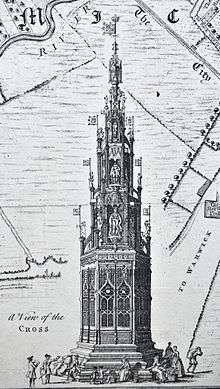William Holles
Sir William Holles (or Hollis) (1471?– 20 October 1542) rose from apprenticeship to a mercer to become master warden of his company and Lord Mayor of London in 1539.[1]

He was the son of Thomas Holles of Stoke, Coventry.[2]
He was admitted to the freedom of the Worshipful Company of Mercers on 17 September 1499, and became master of the company in 1528. He was elected Sheriff of London in 1527.
He was knighted by Henry VIII in 1533, and became Lord Mayor of London on St. Edward's day, 13 October 1539. On 3 January 1539–40 he received in great state Anne of Cleves, on her way through the city, before her marriage[3] On 4 February, Holles and the Aldermen accompanied the king and queen by water to Westminster.[4]
Holles was a wealthy merchant, and besides two houses in London, one in Bishopsgate Street, where he kept his mayoralty, and another in the parish of St Mary-le-Bow, acquired several manors in Derbyshire, Nottinghamshire, Staffordshire, Middlesex and Essex. He also was the owner of Clement's Inn in the Strand.
He died at his house in London on 13 October 1542, and was buried in St Helen's Church, Bishopsgate, where a monument to his memory was erected in the middle of the north aisle. His property portfolio passed down through several generations of the family and became the basis of the property owned by the Earl of Clare. He left the bulk of the estate to his grandson William (grandfather of John Holles, 1st Earl of Clare).
He left £200 (equivalent to £50,950 in 2019)[5] in his will to pay for the Coventry Cross which was built in 1544, and taken down in 1771.[6] A replica was unveiled in 1976.
Family
He married Elizabeth, daughter of George Scopham. Lady Elizabeth Holles died on 13 March 1543, and was buried in St Helen's Church, Bishopsgate. By her will she endowed six almshouses for that parish, leaving the care of their erection to her executor, Sir Andrew Judd.
They had three sons and two daughters
- Thomas Holles
- Sir William Holles (1509–91), who developed Haughton Hall in Haughton, Nottinghamshire,[7] and married Anne, daughter of John Denzel, of Denzel, Cornwall.
- Francis Holles
- Anna Holles
- Joanna Holles
References
- William Holles, Oxford Dictionary of National Biography
- Stoke at British History Online, in Victoria County History, County of Warwick Volume 8, 1969, p.98. Citing Sir William Dugdale, The Antiquities of Warwickshire..., revised by William Thomas, 1730, refuting John Stow who took his father to be another William Holles, a baker in the City of London. Dictionary of National Biography follows Stow, as cited in Joseph Rodgers, Haughton: The rapid rise of the Holles family, The Scenery of Sherwood Forest with an Account of some Eminent People there, 1908; copy online at Nottinghamshire history website
- Baker, Richard (1643). A Chronicle of the Kings of England. p. 50.
- Wriothesley, Charles (1875). A Chronicle of England during the Reigns of the Tudors. Camden Society. p. 111.
- UK Retail Price Index inflation figures are based on data from Clark, Gregory (2017). "The Annual RPI and Average Earnings for Britain, 1209 to Present (New Series)". MeasuringWorth. Retrieved 2 February 2020.
- Coventry Cross at British History Online, in Victoria County History, County of Warwick Volume 8, 1969
- Thomas M Blagg, Haughton Hall, Transactions of the Thoroton Society, XXXV (1931); copy online at Nottinghamshire history website